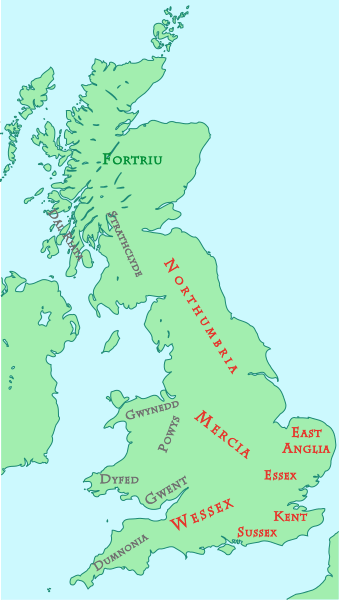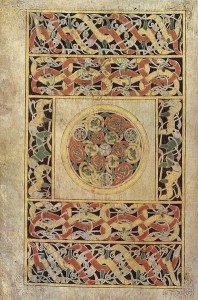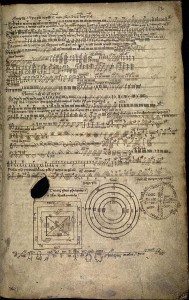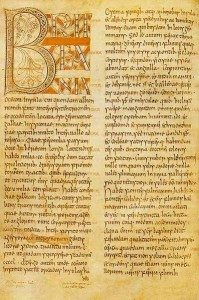When we hear the words “Anglo-Saxon literature,” Beowulf is probably the first thing that comes to mind. Then we might think of the beauty of illuminated manuscripts such as the Book of Durrow or the Lindisfarne Gospels. In this exclusive interview, James Blake Wiener talks with Professor Larry Swain of Bemidji State University about these works, as well as Norse and Irish influences on Anglo-Saxon literature and the significance of the Byzantines, Theodore and Hadrian, who came to Northumbria in the seventh century CE. Professor Swain recommends learning Old English in order to be able to read works in Old English, of course, but equally intriguing, to allow us to better express ourselves in modern English.
JW: Professor Swain, what do you find so compelling about the Anglo-Saxons and their literature? Have you always held an interest in their literature, or did your appreciation grow out of another discipline?
LS: That is a difficult question to answer. For me, interest was piqued through the language. My undergraduate major was Religion-Greek and Linguistics, and I had to take a History of the English Language course where I was introduced to Old English. By that point, I had already had modern German in high school, and Latin, classical Greek, and Biblical Hebrew in college. So I found the sounds and grammar of the Old English language fascinating.
At roughly the same time, I discovered J. R. R. Tolkien, first through his essay “The Monsters and the Critics” and then Lord of the Rings. C. S. Lewis, G. K. Chesterton, Charles Williams, George MacDonald, W. H. Auden and other authors more or less baptized my imagination, and their use of the English language continues to influence my own.
The more I learned of Old English, the more I wanted to learn about the people, history, and the literature. And since I was taught the Historical Critical Method in Biblical Studies, it was very easy to use skills developed there in linguistics, textual criticism, source criticism, and historical context in this new medieval field that had so drawn me all of a sudden. I have been studying the Anglo-Saxons and their culture ever since. Sometimes I think I will take up something else or return to Biblical Studies, and then I just read Beowulf in the original and I am right back into Anglo-Saxon studies.
JW: Professor Swain, when most people think of “Anglo-Saxon Literature,” it is Beowulf that immediately comes to mind. Widely regarded as the first and oldest masterpiece in English literature, Beowulf is read and studied in school and universities worldwide.
What is it that makes Beowulf the quintessential piece of Anglo-Saxon literature? Is it because the poem is full of rich sounds – alliterations and kennings?
LS: That, too, is a difficult question. Joseph Brodsky once said that poets’ biographies are like birds — the data is in the sounds they make. Certainly the sounds of Old English, and a good modern English translation, are hauntingly beautiful. In addition, the poem makes use of our “native meter” in terms of the poetry and alliterates, and when one hears or reads the poem, it becomes memorable. Haunting is a really very good word for this, methinks. Beowulf does indeed haunt the reader.
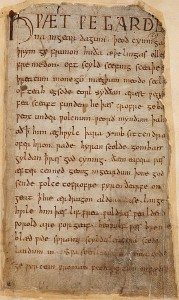
The first folio of Beowulf, written in Old English, 975-1025 CE. MS Vitellius A XV, British Library.
The source for this haunting goes beyond language and the mechanics of oral poetry. The poem has mythic power. Like all the best myths from Classical literature or the Bible, Beowulf’s three episodes, where the hero at different times in his life faces three extraordinary monsters, are mythic and touch chords in the human being as much as anything in The Odyssey and Epic of Gilgamesh. The sadness that pervades the poem, that mourns for a world already gone in the singer’s time and even more removed from ours, touches chords in our own soul, as our world changes so quickly and we look back to the not-so-long-ago that we have already lost. Not just a world lost, but the loss of friends and companions, and ultimately the loss of the hero himself, is also a theme in the poem that resonates with readers.
Getting back to language, you mention the kennings, and certainly the kennings are an attractive and fun feature of the poem. My own favorites are the kennings for the sea: whale-road, swan-path and the like. I could go on at some length, but suffice it to say that the poem creates images that for many readers carry a mythic power conveyed in a language that is beautiful and both known and unfamiliar.
JW: Aside from the acceptance of Christianity in the seventh century CE, which factors facilitated the effervescence of Anglo-Saxon literature and culture during the rule of the Mercian bretwaldas in the eighth century CE?
The majority of Anglo-Saxon poetry in existence dates from this era, as do important prose works like The Ecclesiastical History of the English People by St. Bede (673-735 CE). (It should be noted that this period produced exceptional works of art like the Lindisfarne Gospels and the Book of Durrow, too.)
LS: The eighth century is a period of shift from Northumbrian hegemony to Mercian. The cultural effervescence that you refer to really begins in Northumbria in the seventh century CE. In practical terms, the Northumbrians were experiencing a number of successes in battle against the Picts to the North. This meant an influx of money and other goods into the kingdom. One thing a cultural explosion needs is money.
At the same time, there is an amazing confluence of cultural forces mixing in the kingdom. Christianity is the obvious one that you mention. Christianity brings with it a good dose of Near Eastern culture embedded in the Christian Old Testament. The ancient Hebrews were a tribal people whose culture had some affinities to Germanic peoples’ cultures of the early middle ages. So the Old Testament tales became a way that Christianity could be taught to the Germanic peoples.
Also with Christianity come an alphabet and literacy in Latin. The early medieval world was hungry for “Romanitas” and so while biblical and early Christian texts were imported to England and read and imitated, so were copies of classical Latin texts and Latin translations of Greek works. These, too, were read, devoured, and imitated. In fact, Alcuin, Bede’s intellectual grandson (Alcuin was a student of one of Bede’s students) will toward the end of the eighth century remind his students and fellow monks that as beautiful as the Aeneid is and as moving, it is not Scripture. Scripture, he remarks, must always be the more important text. Of course, as he says this, he continues to allude to Vergil’s work, use Vergillian phrases, etc. Nor is Vergil’s great epic the only such work that they read and appreciated, but other great classics, and some not so classic, influenced their thought and intellectual culture.
In addition to the native Anglo-Saxon culture, the Christian culture, and the Roman, the latter two conveyed through text, that is, through books, a good dose of Celtic culture and thought is added to the mix. In part, this comes from the people that the Anglo-Saxons ruled. While the conquered quickly adapted to the culture and language of the rulers, wholesale abandonment of their previous culture could not happen. But again, more particularly, the Anglo-Saxon ruling house had close ties to parts of Ireland. So when King Oswald, who spent part of his youth in Ireland, comes to the throne in 635 CE, as a Christian he wants to Christianize his people; so it is to the monks on Iona, Irish monks, that he turns. Iona sends Bishop Aidan to Northumbria, and in his wake follow many more Irish monks from Iona and from Ireland itself. The king gives the island of Lindisfarne to Aidan as his principal seat.
The depth of Irish influence on Northumbrian Christianity may be easily seen in the lives of two saints of the period: Wilfrid and Cuthbert. These men are in many ways opposites. Wilfrid is a supporter of the Roman rites, even calling the Irish “heretics”, and presents himself as a defender of the true faith. Yet, even in the story that relates his life written shortly after his death in 709 CE, there are many practices from the Irish tradition that are presented in Wilfrid’s life as being quite normal, including hermits, deliberate physical hardship undertaken to aid in the sanctification of the soul, and other practices. In addition, the author of Wilfrid’s life knows the lives of several Irish saints, especially that of St. Brigid, and imitates those lives in relating the story of Wilfrid. So even this “anti-Irish” saint is so closely tied to Irish cultural elements that he cannot really be maintained as “anti-Irish” at all.
Cuthbert is probably one of the most important saints of the Anglo-Saxon period. Three lives of this saint are written in the thirty years after his death, two of them by the Venerable Bede! The first was most likely written in 698 CE or so, to commemorate the internment of Cuthbert’s remains in the church at Lindisfarne; certainly as Bede relates Cuthbert’s life story, the practices of the Irish church are evident as well.
All this cultural fusion and mixing is occurring at a time that there is some wealth to spread around. This creates a cultural explosion in Northumbria. We see the results in a large number of Latin works such as Bede’s corpus, the anonymous lives of St. Gregory and St. Cuthbert, Latin grammars and metrical instruction, and of course Bibles. We see the results in deluxe manuscripts such as the Codex Amiatinus, Lindisfarne Gospels, the Book of Durrow, among a number of other early and important illuminated manuscripts. We see the results in stone crosses such as Bewcastle Cross and the Ruthwell Cross. In addition, we have artifacts from Cuthbert’s tomb, stained glass from Wearmouth-Jarrow, wall paintings from various churches, and other examples of an explosion of visual arts. Nor should we ignore the Staffordshire Hoard of which we have spoken before as an example of both the wealth and the artistry of this period in Northumbria.
Last, but not least, there is the vernacular literature. Caedmon’s Hymn is probably the most well-known and comes from the middle of the seventh century CE. A version of the poem Dream of the Rood is carved in runes on the sides of the Ruthwell Cross also from the seventh century CE. We also have the “Epinal Glossary,” a collection of Latin words and their Old English equivalents from about 700 CE. Slightly later in the mid-eighth century CE, we think that Beowulf was composed in more or less the form it will later be written in, along with the poems known as Genesis A, Exodus, Deor, Widsith and some other Old English charters. These latter, though, seem to be the last gasp of this cultural explosion that began in the century previous, as after the mid-eighth century CE , there is not much culturally until we reach the “Age of Alfred” in the ninth century CE.
So far, I have talked mostly about Northumbria. But the territory south of the Humber River had a cultural explosion as well, though smaller in scope. Here we have many of the same cultural forces as in the north coming together. In contrast with the north, the south had an extra ingredient: Theodore and Hadrian. Theodore hailed from Tarsus, St. Paul’s hometown, and spent his early career in Byzantium, most likely leaving Tarsus when the Muslim invasions reached there in 637 CE. Theodore spent the next 25 years or so in the Roman capital studying. In the early 660s CE, he went to Rome and there lived with a group of Eastern monks, becoming just as learned in the Latin language and literature as he was in Greek. In 668 CE, the see of Canterbury became vacant when the new archbishop, who was in Rome to receive the papal blessing and the accoutrements of his new office, suddenly died. The pope then selected Theodore as his replacement on the advice a counselor, Hadrian. In fact, the pope had offered the job twice already to Hadrian who had declined it. The pope appointed Theodore on condition that Hadrian accompany him because the latter “knew the road.”
Hadrian was a Berber from North Africa. Little is known of his early life, but he was abbot of a monastery near Naples in 668 CE and had a reputation as a scholar. He also obviously had strong connections in Rome and was both friend and counselor of the pope but also knew Theodore. The two arrived in Canterbury in 669 CE and taught Latin and Greek among other multiple subjects at the school that they founded. There continued to be Irish influences, though one of the students of this Canterbury school, Aldhelm, wrote a letter to his contemporaries pleading with them not to send their students to Ireland any longer but instead to Canterbury.
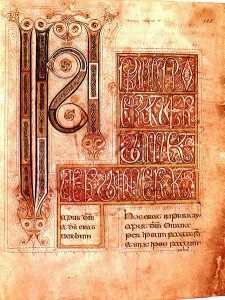
From the Barberini Gospels, the incipit page to John, late 8th century CE, Rome, Vatican City, Biblioteca Apostolica.
Out of this school, which Bede mentions very favorably, a number of important early scholars came, including Aldhelm. In addition to the Latin literature that was being produced in the south at this time, there were Biblical studies and documents on how to operate the church. In addition, there developed shortly after this school’s heyday a Southumbrian school of illumination in manuscripts. The earliest, eighth century CE, manuscripts of this “Tiberius Group” are the Vespasian Psalter, Codex Aureus, and the Barberini Gospels.
Independent of this movement and earlier in Southumbria, we should mention two likely related archaeological finds that demonstrate the wealth and artwork of this region during the sixth and seventh centuries in spite of Northumbrian hegemony. Sutton Hoo and the Prittlewell sites both are graves of kings and/or princes of some note and contain a rich find in artifacts, some from far away in the Eastern Roman Empire, that show both a lively native culture that yet has contacts to the North in Scandinavia as well as the kingdoms of the Franks, Visigoths, and even the remnants of Rome in the east. I will not dwell on these finds, as we could have whole articles about them, but suffice it to say that they are important to fill out our picture of this early period.
So to answer the question, there were a number of forces that came together at a propitious moment in time that produced a vibrant culture, one of the results of which was the production of literature in Latin and in the vernacular English.
JW: The Anglo-Saxon era in England is contemporaneous with the “Age of Saints” in Ireland. Given the proximity of the Anglo-Saxons to their Celtic neighbors in Wales, Scotland, and Ireland, I am curious to know if any Celtic influences can be detected within the corpus of Anglo-Saxon literature.
Cannot the Irish, rather than the English, claim to have the oldest vernacular literature in western Europe?
LS: I addressed that a little in my answer above. But before enlarging, it actually is not the Irish who can claim the oldest vernacular literature in Western Europe. Irish as such is represented in Ogham inscriptions consisting of personal names and not much else. The earliest of these date to the late fourth century CE, but are on the island of Britain, not Ireland, and so are not properly Irish. Nor could one really call these a “literature.”
While there is very little English, nearly contemporaneous in the fifth century CE are the first runic inscriptions on the island in what can then be called “English.”
When we look at what we can call actual literature, English here meets Irish. English literature, whether written in runes or in the Latin alphabet, is contemporaneous with anything in Irish. The earliest example of English we have, though preserved in a twelfth century CE manuscript, are the Laws of Aethelberht, the king who received Augustine of Canterbury in 597 CE. About the same time, the poem Amra Choluim Chille, an elegy on Columba, is composed, thought to have been written very shortly after his death. The attribution of this poem to the poet Dallan Forgail who died in 598 CE cannot be verified. But all agree that it was composed somewhere around 600 CE, making it a contemporary of Laws. In addition, we have two certain literary texts written in runes that date to the seventh century CE: the “Dream of the Rood” version written on the Ruthwell Cross and the texts of the Franks Casket.
Let me be clear: examples of Primitive or even Old Irish language exist in Ogham that predate examples of English language inscriptions, though not by much. Examples of English literature are contemporary with examples of Irish literature, however, but there is more English literature of the seventh century than Irish, at least in the vernaculars.
A third issue is this: Irish vs. English authors writing in Latin. Here, the Irish predate the English with important authors such as Columba, Columbanus, Sedulius, and possibly Pelagius, are all Irish writers writing in Latin. The earliest English writer in Latin is second half of the seventh century CE, so the Irish win that one. There is a great deal of national and ethnic pride involved in assessing these claims about which language is attested first, which language has the first literature etc and that pride is further fueled by the long political issues that have existed between Ireland and England since the Normans came in.
If we ask the question what is the earliest vernacular written in Northwestern Europe, hands down it is vernacular or vulgar Latin in Gaul. Certainly the sermons of Cesarius of Arles and Gregory of Tours, Clovis, and other samples of non-literary Latin in the late fifth and the sixth centuries illustrate that there is a non-literary language being written, a vernacular of the time before it became French. So all the national/ethnic angst about the earliest written vernacular is unnecessary.
But as interesting as that is, your question was about Irish influence in Old English literature. There is absolutely no question of such influence, both early and late, and in Anglo-Latin as well as Old English. I have already mentioned key elements of Irish influence on Latin lives of important English saints in the seventh and eighth centuries CE, Wilfrid and Cuthbert. I could add the influence of a writer called Pseudo-Augustine on other writings of Bede, such as his De Natura Rerum, On the Nature of Things, and exegesis. Irish influence on Anglo-Saxon religious texts is obvious and easy to find. In fact, throughout the Anglo-Saxon period, there is certainly a relationship of Irish scholars being teachers of Anglo-Saxons whether through the written word or more directly. Again,
I have mentioned above the influence in Northumbria, but we could add Irish scholars visiting the courts of Alfred and his grandson, and Irish scholars teaching St. Dunstan, the scholar who started the Benedictine Reform movement in England. Penance and penitentials, guide books to assess the degree of sin and how to atone for it, owe their origin to the Irish church, and the Anglo-Saxons adopted these quickly. Influence on homiletic material is likewise significant, especially in famous sermon collections such as the Vercelli Homilies where the ideas behind certain of the homilies or even whole homilies come from Irish tradition. We can see the influence of Irish texts on the Old English Martyrology; Alfred the Great in translating the first fifty psalms used an Irish source as his prefaces to each psalm indicate, and some have argued that he was influence by Irish sources for his preface to his law code. The works Adrian and Ritheus and Solomon and Saturn are heavily influenced by Irish lore.
That is a very quick overview and consists of influences we are fairly certain about. Some scholars have argued for Irish influence on Old English secular texts with less success. But there can be no question that Irish scholars and authors had a wide influence in Anglo-Saxon period throughout the period.
JW: Old English was heavy influenced by Old Norse as a direct result of the Viking invasions of the British Isles. One might be inclined to suspect that similarities exist between Anglo-Saxon literary styles and those found in Viking Age Scandinavia as a result, but is this truly the case?
LS: I would take this back a bit further, as you know the Anglo-Saxons and the Norse share cultural roots. Both linguistic communities come from what is now northern Germany and descend from Proto-Germanic. In fact, when in the eighth century CE St. Boniface evangelizes among the Frisians and Saxons, closely related language-speakers to Old English speakers, he notes how easily they are able to understand him. So the similarities in style that we find are more due to this shared cultural inheritance than direct influence of Old Norse on Old English.
There are literary differences too. These differences in large part though may be put down to the deliberate “Christianization” and “Romanization” of the culture, making Anglo-Saxon culture a fusion of native Germanic, Christian, and Roman, at least in terms of the literary remains. But that process of fusion certainly does change Anglo-Saxon culture significantly.
A different but just as important question to ask is how Old Norse language influenced Old English, that is more important than an influence on literary styles. Old Norse contributed to the breakdown of the inflections we mentioned above as well as contributed a number of common words to the English vocabulary. That is the short answer anyway.
JW: What challenges have you experienced when working with Old English, and what recommendations can you share with those studying Old English to read Anglo-Saxon literature? Old English is a highly inflected language that has more in common with Icelandic and German than modern American or British English.
LS: I think the most significant challenge has been a sea-change in our culture. Whereas once, one could assume a knowledge of Greek and/or Latin and a good grounding in grammar as prerequisites for college students learning Old English, that simply is no longer the case. It is often a significant struggle for students to get over the initial hump of learning to think about the grammar of their language in a way they have not been previously taught. Once over that hump, the rewards of learning to read Old English become obvious to them, however!
Another challenge is a general one that all of us who study the Humanities and specifically study the past encounter often: What “good” is studying that? Why would anyone want to study Beowulf in the original when we have such good translations and movies? Of course, the connection between those translations and someone who studied Old English well enough to tackle the poem and render a good translation never dawns on such critics. But this is a challenge we face in society at large and in academic institutions in general.
I recommend to students to stay with it! Yes, learning a language, even an earlier form of one’s own language, can be challenging and having one’s instructor consistently ask about “what is the verb in this clause” day in and day out may not be the most scintillating of topics on the surface, but the rewards, I think, are certainly worth it. Another recommendation I would offer is make certain to avail oneself of the many really great tools that are available. In this day and age, many of those resources are available readily online. Third, I recommend developing an aesthetic sense. Most of us know beauty when we see it. One of the things that can become lost in studying Old English, or any language, is the sheer beauty of the sounds and the imagery. So I recommend to students that when feeling overwhelmed, be still and let the sounds resonate, let the images form in your mind and appreciate them.
Having said that, I chafe at the idea that Old English has more in common with German than its own descendant, modern English. Certainly there is more inflection in modern German than in modern English, but there is so much more to a language than mere inflections. Old English is inflected, but not as inflected as say Latin or classical (or even Koine) Greek, and in the Old English period we already see many of those inflections breaking down. The inflections are surface changes in many ways. One of the most significant changes between Old and Modern English is the dependence on word order after the inflections have been collapsed. Old English is a language in flux moving from a Subject-Object-Verb language in large part to our familiar Subject-Verb-Object and we begin to see that transition in the Old English period itself. In fact, once the vocabulary is mastered, most students have little difficulty translating Old English prose even without mastering the inflections just because of sense and word order.
JW: Why we should read and study Anglo-Saxon literature in your opinion, Professor Swain? What rewards and pleasures can it afford those who study it, and how should we assess and analyze its importance?
LS: That is a question that gets us to the very heart of studying anything in the Humanities. Why should we look into anything literary, other than enjoyment and so forth. But let me be specific to the study of Old English if I am able. For Old English specifically, I would say first that studying Old English will automatically mean that the student learns Modern English that much better. Since Modern English is the language in which the student expresses his or her thoughts, feelings, communicates to others, etc., it follows that a better understanding of that language and a deeper knowledge of the background will only enrich the student’s expression of thoughts, feelings, and communication with others, whatever form that may take.
One often hears or is told that nothing compares to Shakespeare or the King James Bible for beauty and influence on English. Studying Old English means that reading Shakespeare or the King James Bible suddenly becomes quite easy rather than difficult and challenging. In fact, mastering Old English all but guarantees mastery of subsequent periods of the language. That in itself is a great advantage.
Finally, it is beautiful and interesting. I love reading Old English aloud, especially in class. The language and literature are meant to be performed aloud; and at least for me and many others, we study this because we find a beauty in it that attracts the mind and the soul. We are not supposed to admit that because it sounds unscholarly, but to be honest that lies at the heart of why anyone does anything they want.
There are other things that may attract someone to study Old English: interest in the period, or entering in a teaching career in English at some point, or an interest in the literature, or liking the professor, or interest in Tolkien, or other reason specific to the individual. But those three above may fit anyone.
JW: Professor Swain, I thank you so much for sharing your expertise and insights!
LS: My pleasure, James! It is a privilege and an honor to be asked to do this!
Image Key:
- This map shows kingdoms in the island of Great Britain at about the year 800 CE. Original uploader was Sakurambo at en.wikipedia, 2008-14-02. (This work has been released into the public domain by its author, Sakurambo at the wikipedia project. This applies worldwide.)
- The first folio of the heroic epic poem Beowulf, written primarily in the West Saxon dialect of Old English. Dates from c. 975-1025 CE. Part of the Cotton MS Vitellius A XV manuscript currently located within the British Library. Original uploader was Earthsound at en.wikipedia, 2013-29-12. (This is a digital photographic copy of the folio and is thus a faithful photographic reproduction of a two-dimensional, public domain work of art.)
- Book of Durrow. Illumination on parchment. Ireland or England (Northumbria), c. 650-750 CE. This item is currently held at Trinity College Library, Dublin. Original uploader was Zenodot Verlagsgesellschaft mbH at en.wikipedia, 2005–20-05. (The work of art depicted in this image and the reproduction thereof are in the public domain worldwide. The reproduction is part of a collection of reproductions compiled by The Yorck Project. The compilation copyright is held by Zenodot Verlagsgesellschaft mbH and licensed under the GNU Free Documentation License.)
- Folio 125 recto from the Barberini Gospels; the incipit page to John. Original uploader was Dsmdgold at en.wikipedia, 2005-08-08. (This is a faithful photographic reproduction of a two-dimensional, public domain work of art. This image is in the public domain because its copyright has expired. This applies to Australia, the European Union, the United States, and those countries with a copyright term of life of the author plus 70 years.)
- Fol. 170r of the Book of Ballymote. Dates from 1390 CE, and is part of the Auraicept na n-Éces, explaining the Ogham script. The page shows variants of Ogham, nrs. 43 to 77 of 92 in total, including shield ogham (nr. 73), wheel ogham (nr. 74), finn’s window (nr. 75). Original uploader was Dbachmann at en.wikipedia, 2005-14-12. (This is a faithful photographic reproduction of a two-dimensional, public domain work of art. This image is in the public domain because its copyright has expired. This applies to Australia, the European Union, the United States, and those countries with a copyright term of life of the author plus 70 years.)
- Saint Petersburg Bede. Dates from c. eighth century CE. It is currently located in Saint Petersburg, Russia at the National Library of Russia. Original uploader was GDK at en.wikipedia, 2005–22-08. (This is a faithful photographic reproduction of a two-dimensional, public domain work of art. This image is in the public domain because its copyright has expired. This applies to Australia, the European Union, the United States, and those countries with a copyright term of life of the author plus 70 years.)
Dr. Larry Swain is professor of English and chair of the English department at Bemidji State University in Bemidji, Minnesota. He earned his BA in Religion-Greek and Linguistics from Seattle Pacific University, MA in Medieval Studies from Western Michigan University, and PhD in English Studies from the University of Illinois at Chicago. He has proficiency in eleven languages, from Old English to Low Old Saxon to Ancient Greek. He has published on topics such as Beowulf, digital Medievalism, and Cuthbert of Lindisfarne, and wrote several articles for The J. R. R. Tolkein Encyclopedia. Dr. Swain is one of the Editors in Chief of The Heroic Age, which focuses on Northwestern Europe during the early medieval period (from the early fourth through 13th centuries CE).
All images featured in this interview have been cited. Unauthorized reproduction of text and images is strictly prohibited. Ms. Karen Barrett-Wilt was responsible for the editorial and publication process of this interview on behalf of James Blake Wiener. The views presented here are not necessarily those of the Ancient History Encyclopedia (AHE). All rights reserved. © AHE 2015. Please contact us for rights to republication.
